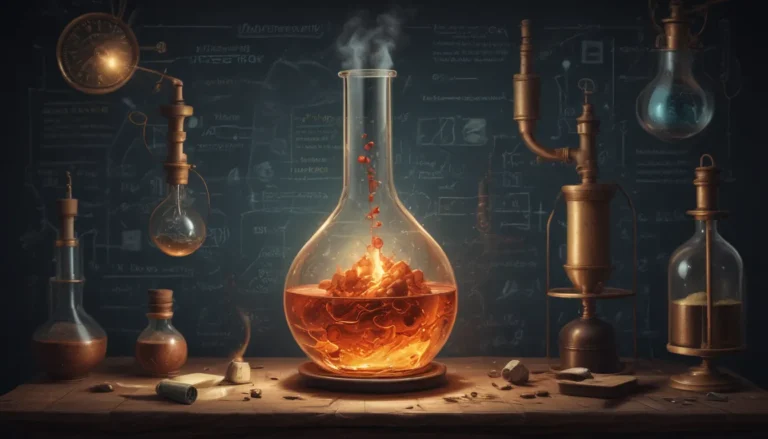A Note About Images: The images used in our articles are for illustration purposes only and may not exactly match the content. They are meant to engage readers, but the text should be relied upon for accurate information.
Are you ready to unravel the mysteries of ATP (Adenosine Triphosphate) and discover the incredible role this molecule plays in the energy metabolism of living organisms? From powering muscle movement to supporting DNA replication, ATP is the superhero energy source of cells that never fails to impress scientists and researchers. In this article, we will delve into 10 unbelievable facts about ATP, shedding light on its fascinating properties and highlighting its significance in various biological processes. So, let’s embark on a journey into the enthralling world of ATP and explore some mind-boggling facts that will spark your curiosity and leave you in awe of this remarkable molecule!
Key Takeaways:
-
ATP is the Energy Currency of Cells: ATP is often referred to as the “energy currency” of cells because it provides the energy required for cellular activities. It powers essential processes such as muscle contraction, nerve impulse transmission, and synthesis of molecules.
-
ATP Consists of Adenine, Ribose, and Three Phosphate Groups: The structure of ATP is composed of three components: adenine, a nitrogenous base; ribose, a sugar molecule; and three phosphate groups. The high-energy phosphate bonds present in ATP store the energy that cells can readily use.
Unveiling the Astonishing Facts About ATP
ATP is Formed Through Cellular Respiration
One of the most remarkable aspects of ATP is its generation through a complex process called cellular respiration. During this process, glucose and other fuel molecules undergo oxidation to produce ATP, which is then utilized for various cellular functions. This highlights the critical role ATP plays in providing the energy required for the survival and functioning of cells.
ATP is Renewable
Unlike other forms of energy, ATP has the incredible ability to be continuously regenerated in cells through processes like cellular respiration and photosynthesis. This constant recycling ensures a steady supply of ATP for powering cellular activities, making it a reliable and essential energy source for living organisms.
ATP is Used in Active Transport
ATP serves as a crucial component in active transport processes that enable cells to move substances against their concentration gradient. This includes the movement of ions, such as sodium and potassium, across cell membranes, showcasing the versatile role of ATP in facilitating essential cellular functions.
ATP Powers Muscle Contraction
The process of muscle contraction relies heavily on ATP, as it is broken down to provide the energy necessary for muscle fiber contraction. This mechanism enables various movements, from lifting weights to running, highlighting the indispensable role of ATP in supporting physical activities and mobility.
The Multifaceted Role of ATP in Enzyme Function
Many enzymes depend on ATP as a cofactor to catalyze chemical reactions within cells. The binding of ATP to enzymes can activate or facilitate their function, ensuring efficient cellular processes and contributing to the overall metabolic activities essential for cell survival and function.
ATP Supports Photosynthesis in Plants
In plants, ATP plays a crucial role in the process of photosynthesis, where it captures light energy to convert carbon dioxide and water into glucose. This not only sustains the plant’s energy requirements but also produces ATP as an energy source for other cellular activities, emphasizing the vital role ATP plays in supporting plant growth and metabolism.
By delving into these fascinating facts about ATP, we uncover the astounding properties and functions of this molecule that make it a fundamental component of life.
Conclusion
In conclusion, ATP (Adenosine Triphosphate) stands out as a truly remarkable molecule that serves as the primary energy source for all cellular processes. Its designation as the “energy currency” of the cell underscores its critical role in powering essential biological activities, from muscle contraction to DNA replication.
Through the hydrolysis of its high-energy phosphate bonds, ATP releases the necessary energy to fuel cellular functions, ensuring the smooth operation of various processes within living organisms. Its ability to regenerate through metabolic pathways guarantees a constant supply of energy for sustaining life and maintaining the energetic balance of cells.
Deepening our understanding of ATP not only advances our knowledge of biochemistry but also offers valuable insights into human health, disease, and potential therapeutic developments. The significance of ATP in cellular processes and its impact on overall well-being highlight the importance of ongoing research and exploration into this fascinating molecule.
As we continue to unravel the mysteries of ATP, we are poised to uncover new discoveries and innovations that will further enhance our understanding of living systems and potentially revolutionize the field of biology.
FAQs
Q: What is ATP?
A: ATP stands for Adenosine Triphosphate, a molecule that serves as the primary energy source for all cellular processes.
Q: How is ATP produced in the body?
A: ATP is produced through cellular respiration, a metabolic process occurring in the mitochondria of cells. It involves the breakdown of glucose and other nutrients to generate energy-rich ATP molecules.
Q: Can ATP be found outside cells?
A: No, ATP is predominantly found within cells due to its high-energy phosphate bonds, which make it an unstable molecule quickly consumed to release energy for cellular functions.
Q: Is ATP only important for human beings?
A: No, ATP is essential for all living organisms, serving as a universal energy currency that powers cellular activities across various life forms.
Q: Are there diseases related to ATP dysfunction?
A: Yes, various disorders, such as mitochondrial diseases and metabolic disorders, can result from ATP dysfunction. These conditions impair the production or utilization of ATP, leading to disrupted cellular function and potential health issues.
Embark on a Journey of Discovery with ATP
Our pursuit of delivering authentic and engaging content is fueled by the contributions of real users like you, each bringing a unique perspective and wealth of insights to our platform. Every fact presented on our site undergoes a meticulous review process by dedicated editors to ensure accuracy and reliability, guaranteeing a rich and diverse collection of information for our readers.
Explore the wonders of ATP, uncover its secrets, and deepen your understanding of this extraordinary molecule that serves as the cornerstone of energy metabolism in living organisms. Join us on this journey of discovery as we navigate the fascinating world of ATP and embrace the endless possibilities it holds for scientific exploration and advancement.






